
(This post is an entry in our spring content contest. If you’d like a chance to win a Beretta APX pistol, click here for details.)
By Jay Gillen
Today, military rifles are built to be lighter, handier, and more ergonomic than ever before. We see these considerations in designs across the spectrum of today’s military rifles. More plastic, lighter rails, lightening cuts etc. etc. However, this was not always the case.
At the beginning of the Great War over one hundred years ago, armies were armed with large, relatively unwieldy bolt-action rifles that might weigh two times your average AR-15. The French standard-issue service rifle was the Fusil Mle 1886 M93, better known as the Lebel.
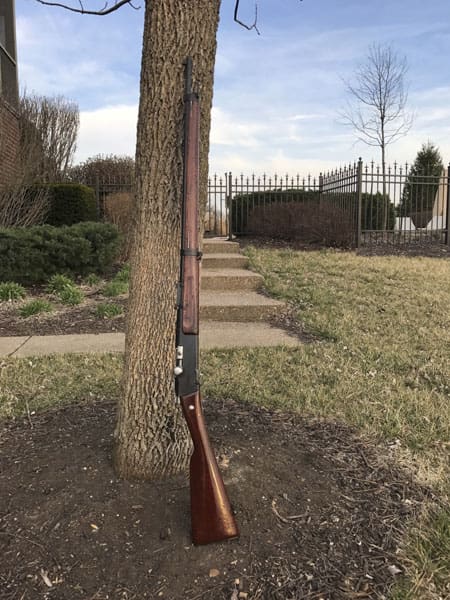
Though tough and rugged, the Lebel was long and heavy, and loading its eight-round tube magazine was agonizingly slow compared to even the Mosin’s stripper clip system (the time it takes to pop in an AR magazine feels like light making the jump to hyperspace compared to the Lebel).
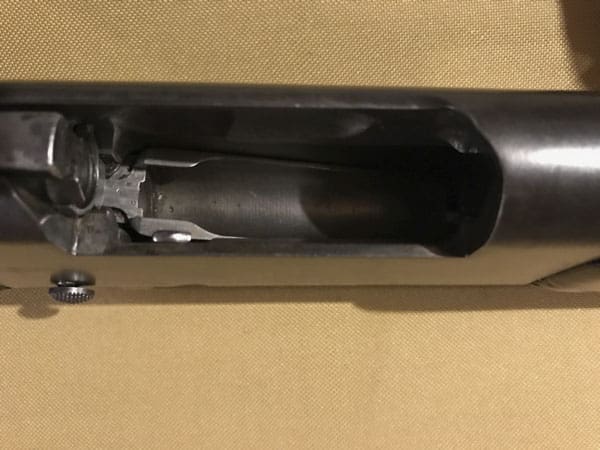
When the war descended into the trenches at the end of 1914, the Lebel followed. In the trenches its length was even more cumbersome, and having to load the tube magazine in a confined area surrounded by angry Germans with saw blade bayonets probably gave the French poilus endless nightmares. However, with the huge losses in rifles resulting from the first massive battles of 1914, a substitute arm began to make its way to the front, and it would become as much of an icon of the French Army in la Grande Guerre as the Lebel.
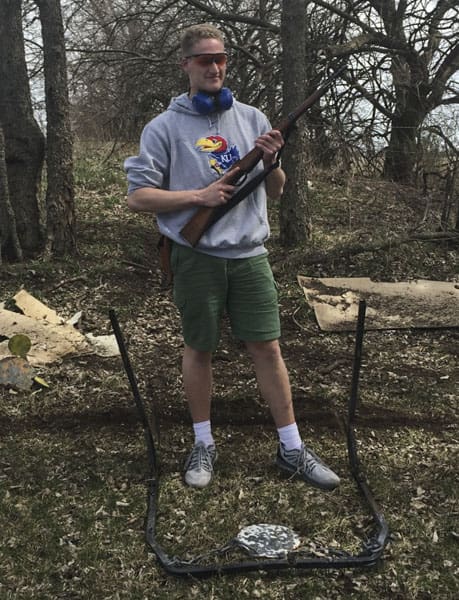
Enter the Berthier M1892 Mousqueton. Designed by Algerian railroad worker Emile Berthier, this carbine was a response to a request for a new shoulder arm for the French cavalry. The Lebel rifle was not suited for mounted troops due (once again) to the tubular magazine and length. It may have made a good lance with the bayonet fixed, but French military thinking had, very recently, moved beyond that.
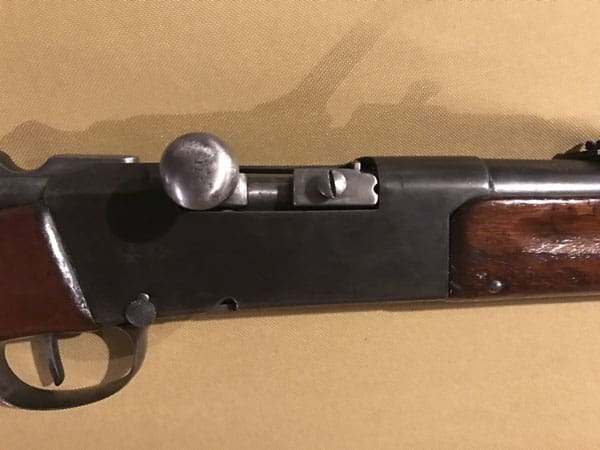
M. Berthier chose instead to simplify the Lebel bolt, which had many machined cuts in it to work the elevator and ejector feed system in the older rifle, and pair it with a Mannlicher style en-bloc clip. It fired the same 8x50mm rimmed ammunition that the Lebel fired, and the clip held three rounds and was reversible (unlike the Mannlicher system it was derived from). The firearm measured just over three feet long at 37.2 inches and was extremely handy. The French cavalry accepted the little carbine, and soon M1892s were passed out to machine gun crews, artillerymen, and other non-frontline troops.
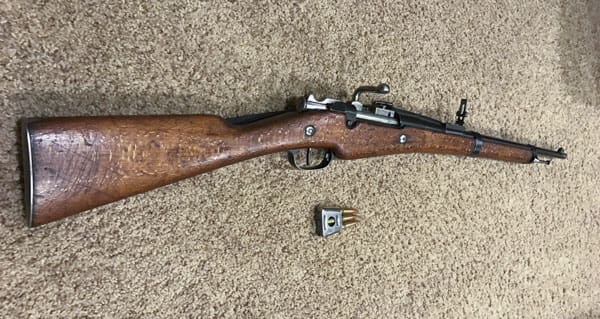
The M1892 was the personal defense weapon of its day, arming those who did not need the weight and length of the full size Lebel. When the war broke out, the M1892 went from being in the background straight to the front lines. The French needed as many guns as they could get, and the M1892 fit the right criteria being an 8x50mm shoulder arm. It served well in the trenches, as its short length and quick loading en-bloc clip made it incredibly maneuverable in the tight confines of the trenches. The Mousqueton was a hit.
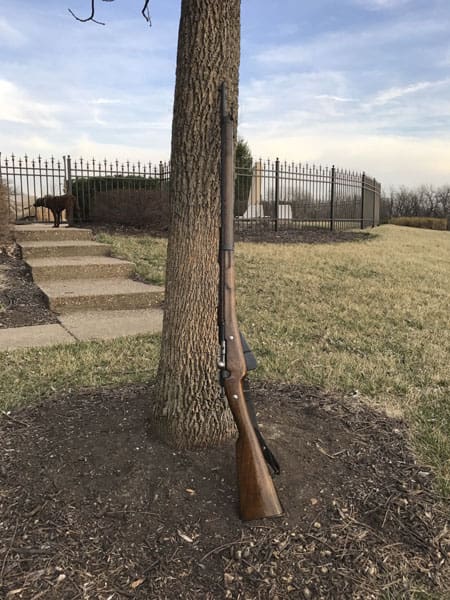
The M1892 would eventually spawn four legendary French shoulder arms: the M1892 itself, the M1907-15 rifle, which supplemented the Lebel while French factories tooled back up to make more of the older, more complex design, and the M16 series of carbines and rifles (the French M16s are quite different than the American ones) with an improved five shot clip and extended magazine housing that enclosed the bottom of the rifle. These firearms would serve with the French throughout World War One and beyond, finally retiring when the last M16 carbines were taken out of service in the 1960s with the Gendarmerie.
My carbine is a pure M1892 Mousqueton. These are relatively rare because most of them were turned into M16s during the course of the Great War. The receiver and barrel were manufactured at the Chatelleraut arsenal in 1914; the year Gavrilo Prinzip ventilated Archduke Franz Ferdinand. World War One French rifles have a beautiful cursive script on the left side of the receiver that marks the arsenal where they were manufactured.
It is a very aesthetically pleasing gun to look at, with smooth, French curves that stand in stark contrast to the rigid, stern lines of its adversary, the Mauser. The stock on this carbine has seen some serious use, with numerous arsenal repairs and patches in different places. This is common for French rifles of the Great War, as is the lack of matching serial numbers. The French cannibalized parts from rifles too damaged to function to repair as many arms as possible and get them back into the fight. The attritional battles chewed up both men and rifles, but rifle parts were reusable.
My dad and I found our little carbine on Gunbroker. The first item of business after I picked the carbine up from the FFL was to field strip it and clean it. The bolt has an extra step to take out compared to other old bolt guns, as you need a screwdriver, but once you do it there’s nothing to it. Open the bolt, unscrew the bolt head retaining screw and remove it, move the bolt slightly forward, rotate the bolt head, then pull back on the bolt body, pulling it out the back of the carbine.
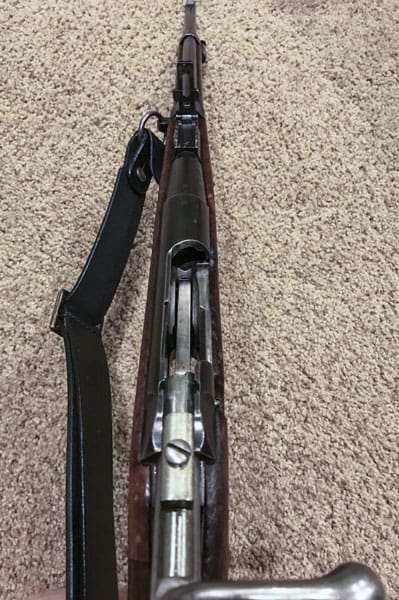
The Lebel and Berthier bolts all had this retention screw, and while its fairly easy to keep track of inside on a mat, I would be very hesitant to remove it were I stationed in muddy, shell pocked Verdun. After cleaning the bore, I put the black leather reproduction sling I ordered from worldwarsupply.com on it, which really compliments its appeal, and completes the look of the carbine.

Then it was on to the range. As the M1892 fires from three-round clips, I ordered three from ebay. Berthier shooters do not have the aftermarket parts supply that the AR-15 community has. Acquiring ammo was a bit of an Internet safari as well. It turns out that Selway Armory carries PPU 8x50mm Lebel on their website, and six boxes were on hand when the M1892 arrived. I packed up the carbine, ammo, clips, and one target and went out to shoot.
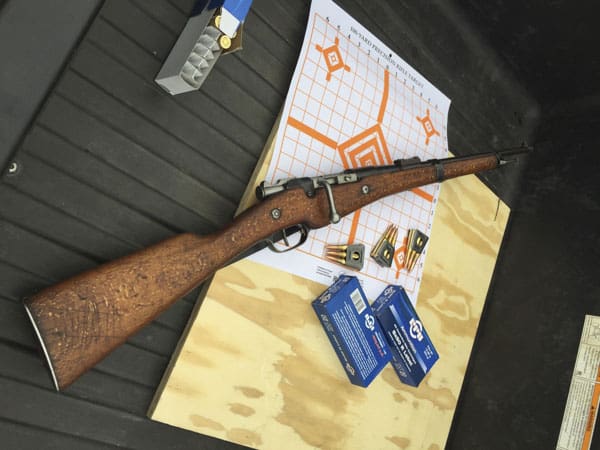
It’s always slightly unsettling to shoot a gun that’s well past the legal retirement age. Made in 1914, the 102-year-old M1892 was the oldest gun in our collection. Eye protection was a definite must. I set up a target at 25 yards, wanting to make sure that some of the $1.25/round Lebel rounds wound up on target. I loaded the clips with French-flavored Serbian bullets and pushed the brass filled sheet metal down into the belly of the rifle. It’s the same action one would use to load an M1 Garand.
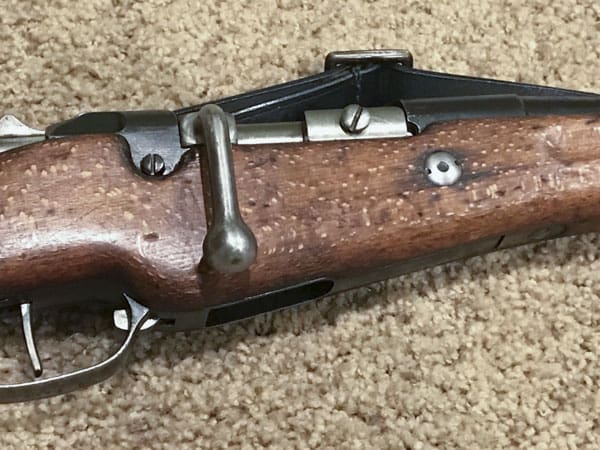
I closed the bolt, took aim, and BANG! That needs to be in all caps because you must understand: this gun is loud. It’s the kind of gun you shoot if you want the whole county to know you’re out shooting. It’s awesome. And it didn’t explode in my face. Reassured by the bolt’s giant locking lugs and the bolt handle acting as an extra-safe safety lug, I continued on with my shooting. In total I put six rounds on the paper, 3 at 25 yards and 3 at 50 yards, with acceptable results. The rounds were on target. In all fairness to the M1892, my rifle was updated to shoot Balle N, a different loading than the original WW1 load that Prvi Partisan uses to make its ammo safe for all 8x50mm rifles. Mais je n’étais pas fini! There was a steel gong to shoot, and I had more ammunition!

To hit the 8-inch plate at 50 yards, I had to hold a good 6 o’clock hold to get the bullet to connect with the steel. The battle sights on the M1892 are set at 200 yards, with a sort of U-and-blade sight. The sights are graduated out in increments of 200 meters to 800, and then if you flip up the ladder sight you get an incredibly ridiculous number that I looked at once, laughed, and flipped back down to the battle sights. 100 yards was a similar story to 50, with the sights on the gong in a pumpkin-on-a-post fashion. However, for its mediocre performance on paper, the Berthier connected all three of those rounds I launched at the plate at 100. Satisfied, I decided to try offhand at 50.
While the M1892 is slightly awkward to shoot off of a rest due to its short size and stout recoil, it is truly at home on the shoulder. The gun handles incredibly well. The cock-on-open bolt is smooth to operate, and the long bolt handle gives the shooter plenty of leverage to crack the action open and shuck it. The trigger is decent, but oddly straight and paddle shaped. It is a standard two-stage military rifle trigger.
Pointing the M1892 felt natural. There was no weight way out in front of me pulling the front sight downwards; the weight of the rifle stays close to the receiver back near the shooter. It reminds one of a Tavor SAR, if I can make that leap (however, the Berthier’s trigger is better out of the box). After smacking the plate one final time, there was a faint ping as the clip dropped out of the bottom of the rifle. Satisfied with my shooting, I went back inside and cleaned my fusil while blasting some French Army marches on my stereo.
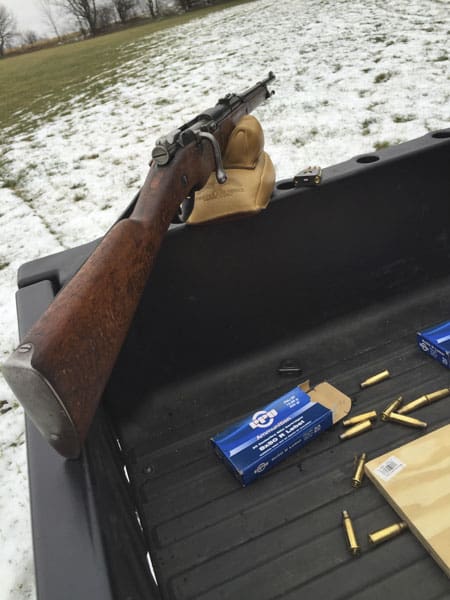
I have taken the M1892 out a few times since then, mostly to show off the exotic looks and relative rarity of the rifle. With ammo being scarce from time to time, it’s not an every Saturday shooter. However, it has always made heads turn wherever I’ve taken it. While I was shooting it with my friend and his dad, who were plinking away at our steel gong with their AR-15, the M1892 launched an 8mm Lebel pill that blew the gong backwards with such force that when it came back forward, it yanked the stakes out of the gong stand and toppled flat on its face.
It doesn’t seem that the short barrel affects its punch much at all. My last outing with the M1892 was at the Mill Creek Shooting Range near Kansas City for one of their World War One themed shooting matches (if you live in the area, definitely check them out). I shot it in their 100-yard off-hand carbine run, and though I didn’t win, it was fun to have the other shooters come over and oogle the little Mousqueton, as well as having an excuse to wear my replica French Adrian helmet.
Now for some final thoughts on the Berthier M1892. The Berthier served a niche role in the French Army during the Great War, and proved to be a handy, reliable trench sweeper. Today, it has passed into well-deserved retirement. No gun buyer is going to see a Berthier Mousqueton and think, “ah, that’s the perfect home defense gun,” unless you live in a blood soaked trench in Flanders.
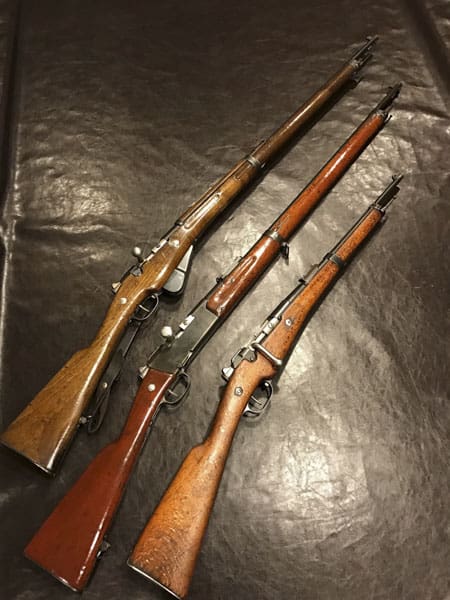
It’s not a hunting rifle, though its lightweight and powerful cartridge might allow you to take a boche pig or a coyote Kaiser. The main reasons to own an M1892 is its sheer cool factor and its connection to the 20th Century’s first great conflict. You can see it in the character French rifles of the era carry with them. My M1892 has a series of ten tally marks on the right side of the buttstock that are visible in some of the photos. The numerous repairs on the stock are a testament to its service.
For the French arms collector or the World War One military collector, this carbine is a must have. For me, a European History Major who has just started an honors thesis about the French Army during La Grande Guerre, shooting and handling this carbine was truly a dream come true. It was the first in our World War One rifle collection, and spurred me on to purchase a Lebel Mle 1886, and my dad to get a Berthier M16. The M1892 holds a special place in our collection of rifles and in history, and if you come across one for the right price and don’t care about ammunition cost, a Mousqueton might certainly be the piece de résistance of your milsurp collection.




“Slightly Used”, “Only Dropped Once”.
Sorry, it’s French, and I’m a little snarky today.
Viva Le France.
Ah, that bit never gets old. However, you might want to give Tuchman’s “Guns of August” a read, or maybe Mr. Gillen has a few recommendations.
Will do. Thank you. I have my own collection of war horses and enjoy them at the range as often as I can. From 1891 Argentine Mausers, to K-31 Swiss, to of course, a few Moisin’s, and my beloved Garand, nothing beats the wood and iron of these rifles.
Including Krag, Arisaka, Enfield, Lebel, Mannlicher, and the one featured in the OP.
For those that go down that path, there is nothing like the sore shoulder and big smile after firing these rifles.
Like the French-built tanks in WWII. One forward gear, and six reverse gears.
I’ll never apologize for poking fun at the French.
Interesting, the close up of the wood grain and bolt picture, the wood grain almost looks like digital camouflage.
Love these old gun articles.
Huh. You know, that might make for a fun project. Wood AR furniture stained in a digital pattern.
looks like quarter-sawn oak.
What’s the white flag capacity?
Given the price of ammunition, is reloading practical?
I would save every spent shell. I’m sure an 8mm head would mount right in.
Good stuff I love a bit of history.
+1
Neat rifle. Interesting article.
One thing you quickly realise when shooting old military surplus rifles with obsolete calibers is you have to start reloading. Otherwise it can be very expensive buying factory ammunition at prices that make M855 users weep.
The review is nicely done but you need a good editor so as to avoid such things as “compliment” vice “complement” and “oogle” vice “ogle”. Otherwise, a fine and informative piece of prose about a rifle of which few of us are familiar.
That’s a damn fine lookin’ Musketoon!
“It’s the kind of gun you shoot if you want the whole county to know you’re out shooting.”
Oh, so that was YOU!
yup, its the same with my mosin m38 carbine, KABOOOM!!
And then everyone stands around blinking from the muzzle flash and ears ringing if they didn’t put their ear pro on right.
Favorite story, I went to a public range on forest service with about 4 benches for use. there was a old guy at the far end shooting his scoped pistols and the other 3 benches full of about 9 Hispanic guys shooting their 9mms and ar15s all without PPE.
our group of 4 had just arrived and I was eager to try out my new mosin, so me and my brother took a clip each and went to the end of the benches and we unloaded 10 rounds fairly quickly. 5 minutes later, all the guys without ear plugs had disappeared and we had our choice of benches.
I call my M44 the range clearance device. 5 rounds out of that thing and people pack up and leave.
Finally found an M16 I can legally purchase in California!, once I take the blood oath, the future intent tests, and donate to the Pelosi, Bloomberg, and Newsom campaigns (sarcasm drop).
Generally a good article, but this is not accurate: “At the beginning of the Great War over one hundred years ago, armies were armed with large, relatively unwieldy bolt-action rifles that might weigh two times your average AR-15.”
Lebel 1886: 9.2 lbs.
SMLE Mark I: 9.2 lbs.
Gewehr 98: 9.0 lbs.
Mosin-Nagant M91/30: 8.8 lbs.
M16: 7.2 lbs.
M4: 6.4 lbs.
Even in the worst case comparison – Lebel or SMLE vs. M4 – the WWI rifles are only 44% heavier. And there aren’t many AR-15’s under 7 lbs. once people get done bolting on fancy handguards and accessories.
Nice post. Helps us remember that shooting is fun.
We may not use these for defense, but i sure would hate to have one pointed at me.
Nice to remember that progression of guns that led to today.
They are art at it’s best.
“loading its eight-round tube magazine was agonizingly slow compared to even the Mosin’s stripper clip system”
The issue with Mosin stripper clips is the vast array of crappy aftermarket ones that confuse people into thinking they are the genuine deal but aren’t made right which has given it a bad rep.
When you actually find GENUINE Mosin stripper clips like I have (East German manufacture) they work well. Ironically it is smoother and faster to load my Mosin with the proper stripper clip than it is my Mauser.
Excellent informative article. these rifles and carbines are really time machines which transport you back into history.
I also live in the KC area and inherited an M1892 that is in basement shape and as far as I know has not been fired since the First World War. Is there a gunsmith in the area that you’d recommend for antiques like this? I’d love to take it out now and then, but I’d like a professional to give it a clean bill of health first.
Yes, Michael Allee of “Gun Smithing Only” in Shawnee KS is a great gunsmith who can inspect your rifle. http://www.gunsmithingonly.com.
Comments are closed.